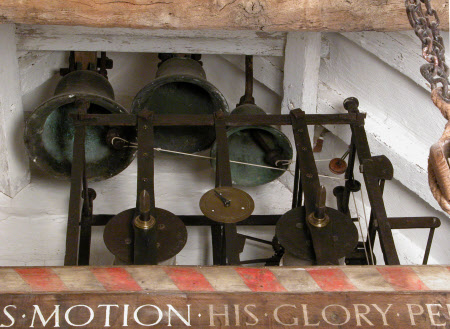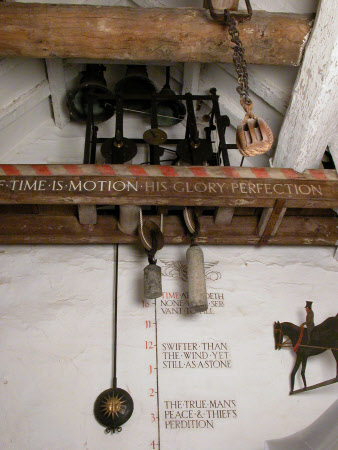Untitled
W. Jones (fl.1803)
Category
Horology
Date
1803
Materials
Place of origin
Abingdon
Order this imageCollection
Snowshill Manor and Garden, Gloucestershire
NT 1333376
Summary
Turret clock with three bells, in iron frame, signed 'W. Jones, Abingdon, 1803', dead beat anchor escapement 1 1/4 seconds pendulum, iron frame, brass wheels, going-weight shows time on a scale painted on the wall with riddles about time adapted by Charles Wade from Nicholas Breton, c.1600. Sun fire insurance mark on pendulum. 'Turret clock in iron frame, signed 'W.Jones, Abingdon, 1803'. Two train 'birdcage' construction with dead beat escapement and locking plate striking. The going weight shows time on a scale painted on the wall. The scale is taken from the writings of Nicholas Breton, 1615 - 'The life of time is motion - his glory perfection. Time attendeth none yet is servant to all. Swifter than the wind yet still as a stone. The true man's peace and the thief's perdition. The lawyer's gain, the merchant's hope. He openeth the eye of day and spreadeth the cloak of night. Agent of the living, register of the dead'. Three bells - C.W. Hitchings, Malmesbury, August 1936' (M Jessup). In his notebook (SNO.MISC.974) Wade refers to a clock in Top Gallant 'The Clock came from GT MILTON CHURCH, OXFORDSHIRE' (pg 68)
Full description
Arranged much like the smaller turret clock in Unicorn (1333403), the clock in Top Gallant is positioned on a platform up among the roof timbers. A ladder that has to be erected for the purpose of inspection. There are three small bells with the clock, although these are known to have been acquired separately (see below). On the front of the beam is the painted inscription “The life of time is motion his glory perfection”. The time is indicated by the fall of the weights against a scale painted on the wall with a heading taken from the writings of Nicholas Breton (1615) beginning “Time attendeth none yet is servant to all …”. SNOWSHILL MANOR: The bells 7 The clock is a large two-train movement in a wrought iron birdcage frame. Unusually, it strikes the ting-tang quarters from the great wheel as well as striking the hours from the same train. It is signed and dated on the brass setting dial by “W. JONES / ABINGDON / 1803” – a maker apparently not mentioned in the standard lists of clock and watchmakers. According to an older version of the National Trust Guidebook (1969) this clock, then in Mizzen, was said to have come from Great Milton Church, Oxfordshire. However, Beeson (op.cit. pp.46-7) states that the Great Milton clock (still there) was made by Nicholas Harris of Fritwell in 1699 so there must be some doubt regarding the suggested provenance. The three bells (of which only two are used for the clock) hang above the clock movement, the opposite ends of their headstocks resting on two parallel beams fixed between the roof purlins on opposite sides of the roof. The bells are probably the “3 bells” bought by Wade from C.W. Hitchings of Malmesbury in August 1936 for £7 5s. This need not mean that they were originally from the same set. It is more likely they were bells that Hitching
Makers and roles
W. Jones (fl.1803), creator

